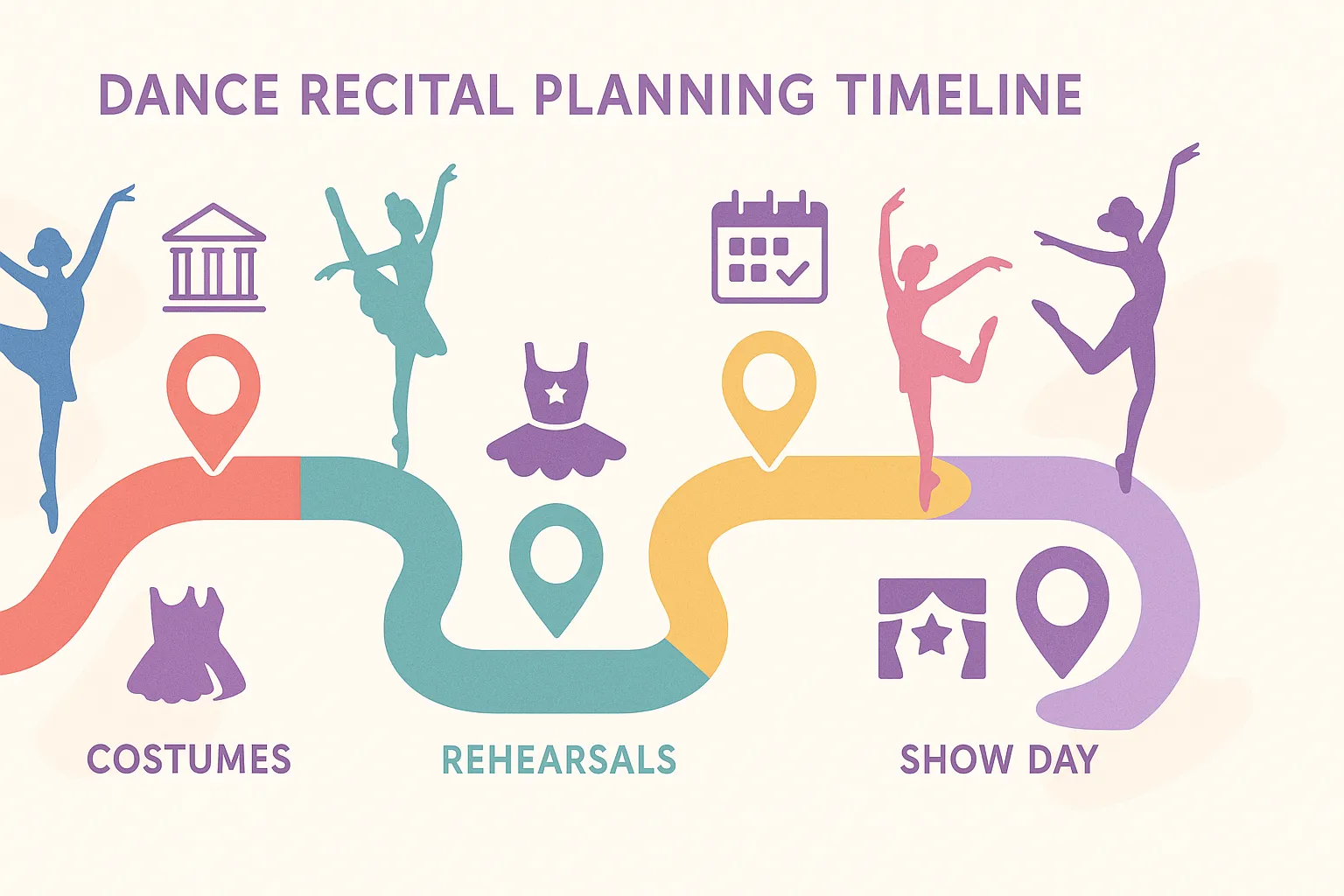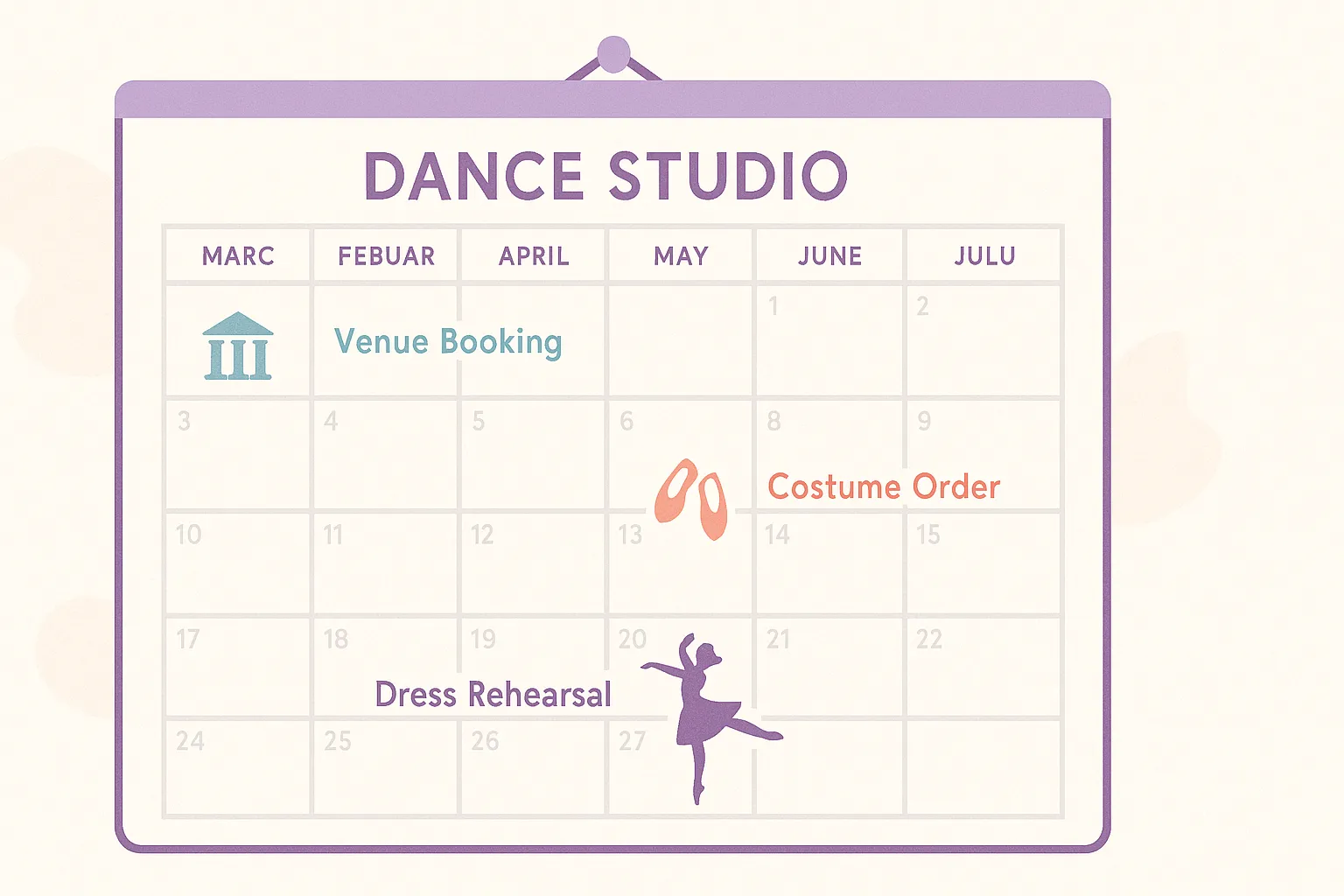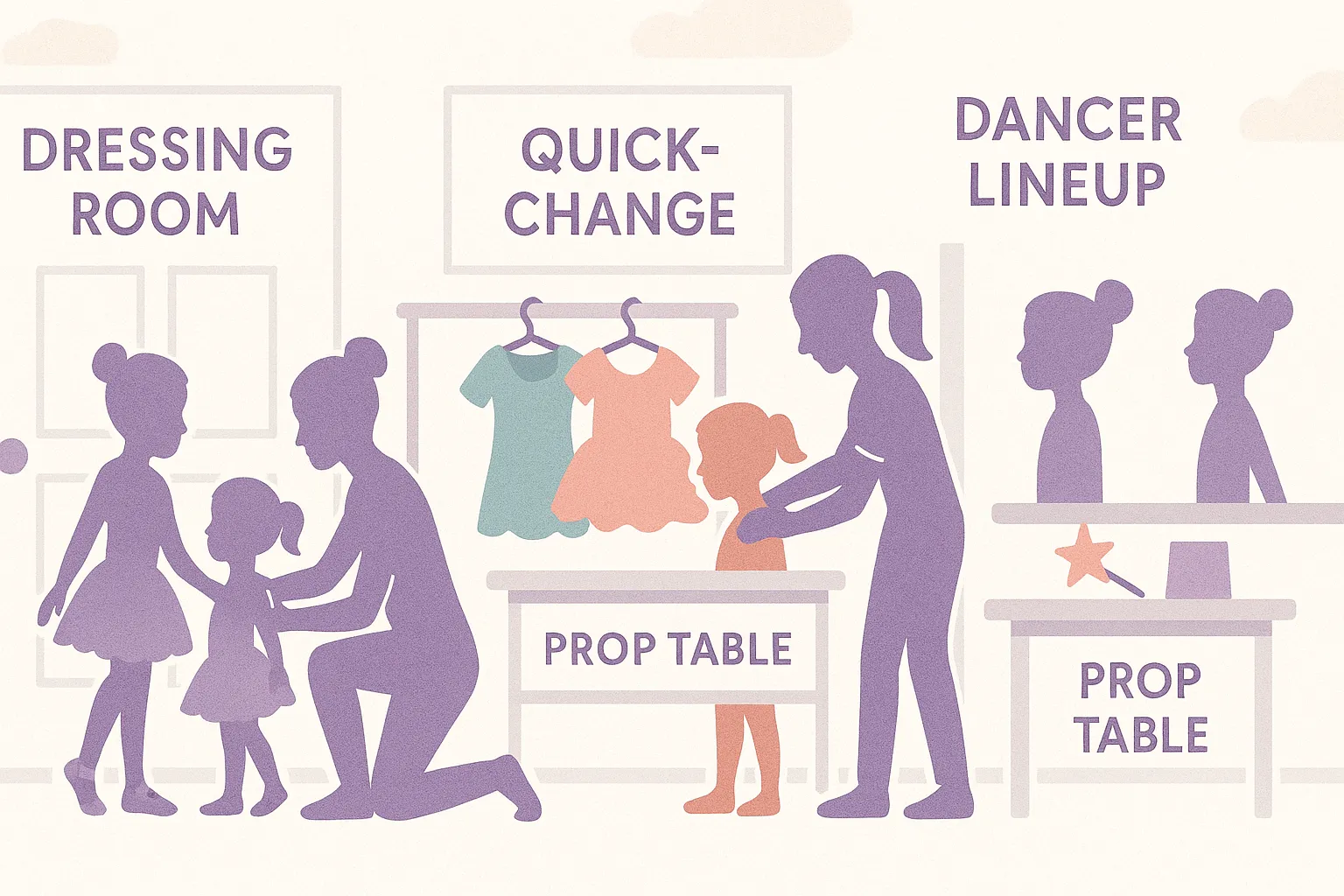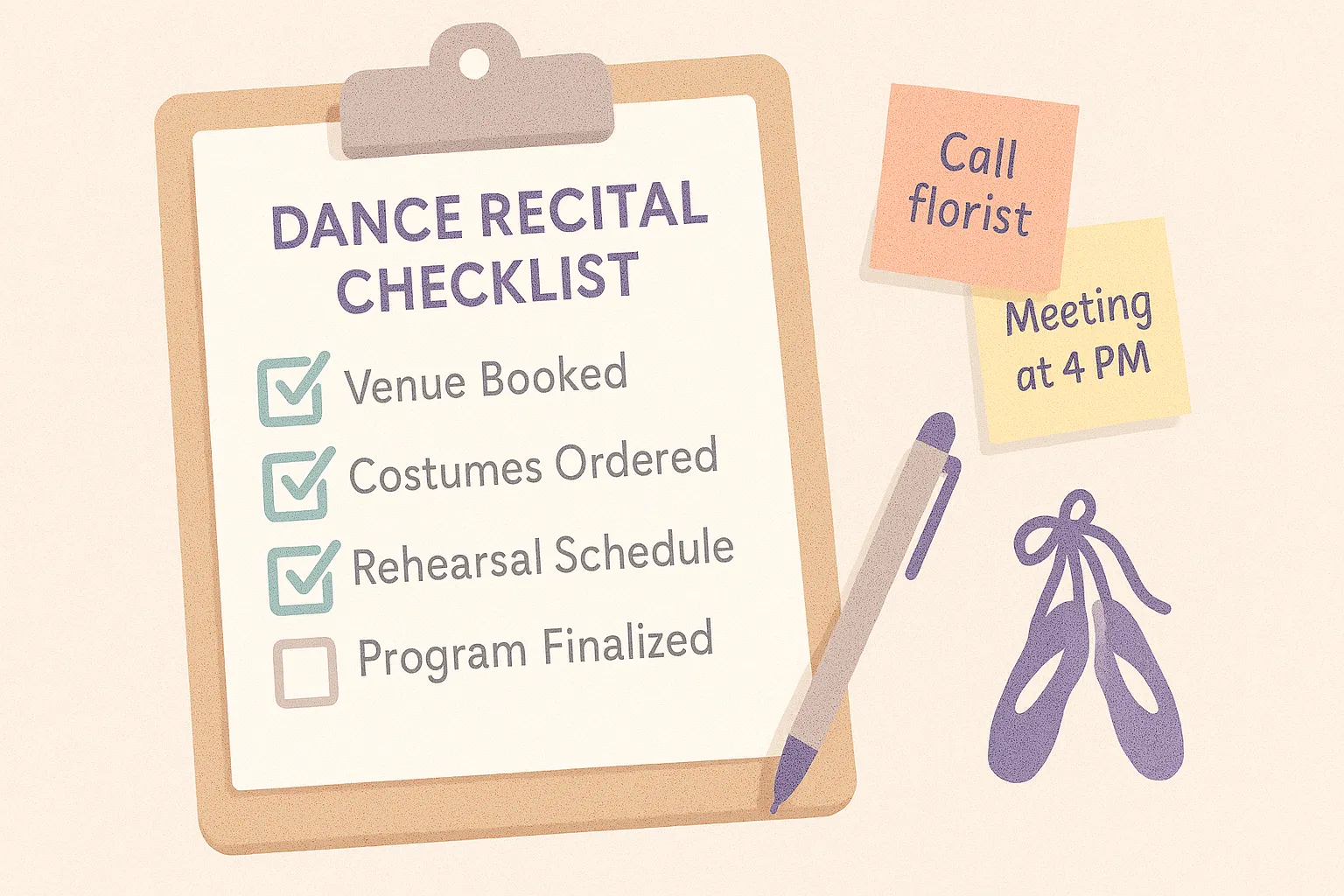Creating a Dance Recital Timeline: A Step-by-Step Planning Schedule for Studio Success
Introduction
Planning a successful dance recital requires meticulous organization and forward-thinking. Without a structured timeline, dance studio owners often find themselves scrambling last-minute, leading to unnecessary stress, rushed decisions, and potential oversights. A well-crafted timeline is the backbone of recital planning, providing a roadmap that ensures all essential tasks are completed at the optimal time. As part of your overall recital planning strategy, establishing a clear timeline is perhaps the most crucial first step you can take. This guide will walk you through creating a comprehensive timeline that transforms the potentially overwhelming recital planning process into manageable, sequential steps that lead to a memorable, stress-free event.

Why a Recital Timeline Matters
Before diving into the specifics, it’s important to understand why timeline planning deserves dedicated attention. A dance recital represents the culmination of your studio’s hard work throughout the year, showcasing student progress and engaging your community. Unlike regular classes or small performances, recitals involve numerous moving parts—from venue booking and costume ordering to choreography development and technical rehearsals.
Early planning is not just helpful; it’s essential. The most successful studios begin their recital planning 6-12 months in advance, allowing ample time for thoughtful decisions rather than rushed compromises. Studios that wait until the last few months often face limited venue options, rush fees on costumes, and compressed rehearsal schedules that can affect performance quality. Additionally, a well-structured timeline provides peace of mind for your staff, dancers, and their families, as everyone knows what to expect and when.
The timeline serves as your master checklist throughout the planning process, ensuring no critical element is overlooked.
Core Timeline Components

6-12 Months Before: Laying the Foundation
July-August (For June Recitals)
The earliest stage of your timeline should focus on big-picture planning and securing essential elements that require long lead times.
Key Milestones:
-
Set recital goals and vision: Define what success looks like for your studio. Is the primary purpose to showcase technical progress, tell a story, or celebrate your dance community? These goals will guide subsequent decisions.
-
Select a theme: Choose a theme that can unite your performances and inspire choreography. Whether it’s “Journey Through The Seasons,” “Broadway Nights,” or something unique to your studio, an early theme decision helps create a cohesive show.
-
Book your venue: This is arguably the most time-sensitive task. Popular performance venues often book up to a year in advance, especially during popular recital seasons (May-June). When selecting a venue, consider:
- Audience capacity
- Stage dimensions
- Dressing room facilities
- Technical capabilities (lighting, sound)
- Accessibility
- Cost and contract terms
-
Set the date: Once your venue is secured, confirm and announce your recital date. Check for potential conflicts with local school events, holidays, or other community activities.
-
Create your budget: Outline all anticipated expenses, including venue rental, costumes, programs, staff, music licensing, and technical equipment. Early budgeting allows you to set appropriate recital fees and identify opportunities for cost savings.
-
Select music and begin choreography planning: Give teachers time to select music that fits both their class level and the recital theme. Begin early discussions about choreography concepts.
4-6 Months Before: Development Phase
September-November
This phase focuses on transforming your vision into concrete plans and beginning implementation.
Key Milestones:
-
Finalize music selections: Complete all music choices and create a preliminary show order to identify any duplicate songs or stylistic imbalances.
-
Integrate choreography into classes: Begin teaching recital choreography in classes, allowing ample time for students to master the material without feeling rushed.
-
Order costumes: This is crucial to do early, as costume companies often have 8-12 week delivery times, plus you’ll need additional time for alterations. Collect measurements and place orders with sufficient buffer for shipping delays.
-
Begin parent communications: Send initial information about the recital date, theme, and general expectations. Early communication helps families plan and gets everyone excited.
-
Arrange for photographers/videographers: Book professionals early, as quality vendors fill their schedules quickly during recital season.
3-4 Months Before: Production Planning
December-January
This phase focuses on technical aspects and logistical planning.
Key Milestones:
-
Conduct mid-year progress assessment: Evaluate how choreography is developing in each class and make any necessary adjustments.
-
Finalize venue details: Confirm technical requirements, schedule a venue walk-through, and discuss lighting and sound needs with venue staff.
-
Begin volunteer recruitment: Identify volunteer needs (backstage help, ushers, ticket sales) and begin recruitment.
-
Set up ticketing system: Determine ticket prices and select a ticketing platform. Prepare for ticket sales to begin in the coming months.
-
Plan recital program: Start designing your program, collecting ads or shout-outs from families, and organizing dancer information.
2-3 Months Before: Refinement Phase
February-March
This phase focuses on refining performances and finalizing logistics.
Key Milestones:
-
Schedule dress rehearsals: Book additional rehearsal time at the venue if possible, or schedule in-studio dress rehearsals.
-
Finalize show order: Create a definitive program order that considers quick changes, style variety, and audience engagement.
-
Begin costume fittings: As costumes arrive, schedule fittings and arrange for any necessary alterations.
-
Launch ticket sales: Open ticket sales to families, with a schedule for priority purchasing if applicable.
-
Coordinate with technical staff: Finalize lighting cues, sound requirements, and any special effects.
-
Assign volunteer roles: Confirm volunteers and assign specific responsibilities.
1 Month Before: Final Preparations
April-May
This phase focuses on fine-tuning and ensuring all elements come together seamlessly.
Key Milestones:
-
Conduct full run-throughs: Practice full dances with music in class, focusing on performance quality and formation changes.
-
Distribute detailed information packets: Send comprehensive information to families covering schedules, what to bring, hair/makeup requirements, and procedures.
-
Finalize backstage plans: Create detailed backstage maps, dressing room assignments, and quick-change stations.
-
Complete program printing: Finalize and print recital programs.
-
Prepare student recognitions: Organize any certificates, awards, or special recognitions to be presented.
-
Hold teacher/volunteer meeting: Conduct a comprehensive briefing to ensure everyone understands their responsibilities.
Final Week: Show Time
Late May-June
This phase is all about execution and creating a memorable experience.
Key Milestones:
-
Technical rehearsal: Run a full technical rehearsal at the venue with lighting, sound, and transitions.
-
Dress rehearsal: Conduct a complete dress rehearsal with costumes, hair, and makeup.
-
Finalize ticket sales: Close online sales and prepare for at-door purchases.
-
Venue setup: Prepare the venue with any decorations, signage, or special equipment.
-
Show day checklist: Create a minute-by-minute schedule for the day of the recital.
-
Post-show plan: Arrange for cleanup, costume collection, and any celebrations.
Practical Application: Making Your Timeline Work
 Creating a timeline is only the first step—implementing it effectively requires strategic approaches and consistent follow-through.
Creating a timeline is only the first step—implementing it effectively requires strategic approaches and consistent follow-through.
Visualization and Distribution
Make your timeline visible and accessible to all stakeholders. Consider these implementation strategies:
-
Create a master calendar: Use a digital calendar (Google Calendar or studio management software) with reminders for key deadlines.
-
Develop a visual timeline: Create a large wall chart for your studio office showing major milestones. Color-code by category (costumes, venue, choreography, etc.) for easy reference.
-
Share with staff: Distribute personalized timelines to teachers highlighting their specific responsibilities and deadlines.
-
Family communications: Create a simplified version for families that includes the dates most relevant to them (costume payments, photo days, rehearsals, etc.).
Tracking and Accountability
Maintain momentum throughout the planning process:
-
Weekly check-ins: Schedule regular staff meetings to review timeline progress.
-
Task ownership: Assign specific staff members to own different aspects of the timeline.
-
Digital task management: Use project management tools like Trello or Asana to track tasks and deadlines.
-
Buffer periods: Build in cushion time for unexpected delays, especially for critical items like costume ordering and venue booking.
Common Timeline Pitfalls and Solutions
Avoid these frequent timeline challenges:
-
Underestimating costume lead times: Order costumes at least 5-6 months before your recital. If timing is tight, consider stock costumes from companies with faster shipping.
-
Venue booking conflicts: Have backup dates and alternative venues in mind. Be flexible with day of week or consider morning/afternoon shows if evening slots are unavailable.
-
Choreography delays: Set internal deadlines for choreography completion. Consider having periodic “show and tell” sessions where teachers demonstrate progress.
-
Communication gaps: Implement a consistent communication schedule. Send monthly recital updates until the 2-month mark, then increase to biweekly, and weekly in the final month.
-
Volunteer shortages: Recruit volunteers early and offer incentives like prime seating or recital DVDs. Create clear, manageable volunteer roles with written descriptions.
Mini-FAQ: Timeline Questions
How early is too early to start planning a dance recital?
You can never start too early! Many professional studios begin planning their next recital immediately after the current one concludes. At minimum, venue booking should happen 9-12 months in advance, especially in competitive markets. The rest of your timeline can be built around that cornerstone commitment.
What if I’m running behind on my timeline?
Prioritize the time-sensitive elements first: venue booking, costume ordering, and communication with families. You may need to make compromises, such as selecting in-stock costumes with shorter delivery times or simplifying production elements. Remember that a streamlined, well-executed show is better than an ambitious one that feels rushed.
How do I create appropriate buffer time in my timeline?
A good rule of thumb is to add 2-4 weeks of buffer time for any element that involves third parties (costume companies, venues, etc.). For internal deadlines, add 1-2 weeks of buffer. Communicate earlier deadlines to your team than you actually need, giving yourself wiggle room.
Should my timeline change based on recital size?
Yes, but not as much as you might think. While a smaller show requires less logistical coordination, the core milestones remain similar. Larger productions may need additional lead time for complex elements like set design or multiple show coordination, but the basic structure of 6-12 months of planning is recommended regardless of size.
How do I keep my staff aligned with the timeline?
Regular check-ins are essential. Consider monthly “recital planning” meetings that gradually increase in frequency as the show approaches. Create individual responsibility timelines for each staff member and build accountability with regular progress reports. Celebrate timeline milestones to maintain momentum and enthusiasm.
How detailed should my timeline be?
Your master timeline should include all major milestones and deadlines. For the 1-2 months before the recital, break down tasks into weekly and even daily action items. The further out from the recital, the more general the timeline can be, focusing on monthly objectives rather than specific tasks.
Conclusion
 A thoughtfully crafted recital timeline transforms what could be a chaotic process into a methodical journey toward a successful performance. By starting early and breaking the planning into manageable phases, you create space for creativity to flourish without the pressure of looming deadlines. This approach allows for more deliberate decision-making, better budget management, and ultimately a higher-quality production that showcases your dancers at their best.
A thoughtfully crafted recital timeline transforms what could be a chaotic process into a methodical journey toward a successful performance. By starting early and breaking the planning into manageable phases, you create space for creativity to flourish without the pressure of looming deadlines. This approach allows for more deliberate decision-making, better budget management, and ultimately a higher-quality production that showcases your dancers at their best.
Remember that your timeline should be a living document, adaptable to your studio’s unique needs and circumstances. As you gain experience with recital planning, you’ll refine your timeline to reflect what works best for your teaching staff, student population, and community context. The goal isn’t rigidity but rather creating a framework that provides structure while allowing flexibility when needed.
For more comprehensive guidance on all aspects of recital planning, including budgeting, venue selection, and marketing strategies, refer to our upcoming complete guide to planning and executing a memorable dance recital. With a solid timeline as your foundation, you’re well on your way to creating a recital experience that will delight your dancers, impress their families, and showcase your studio’s excellence.